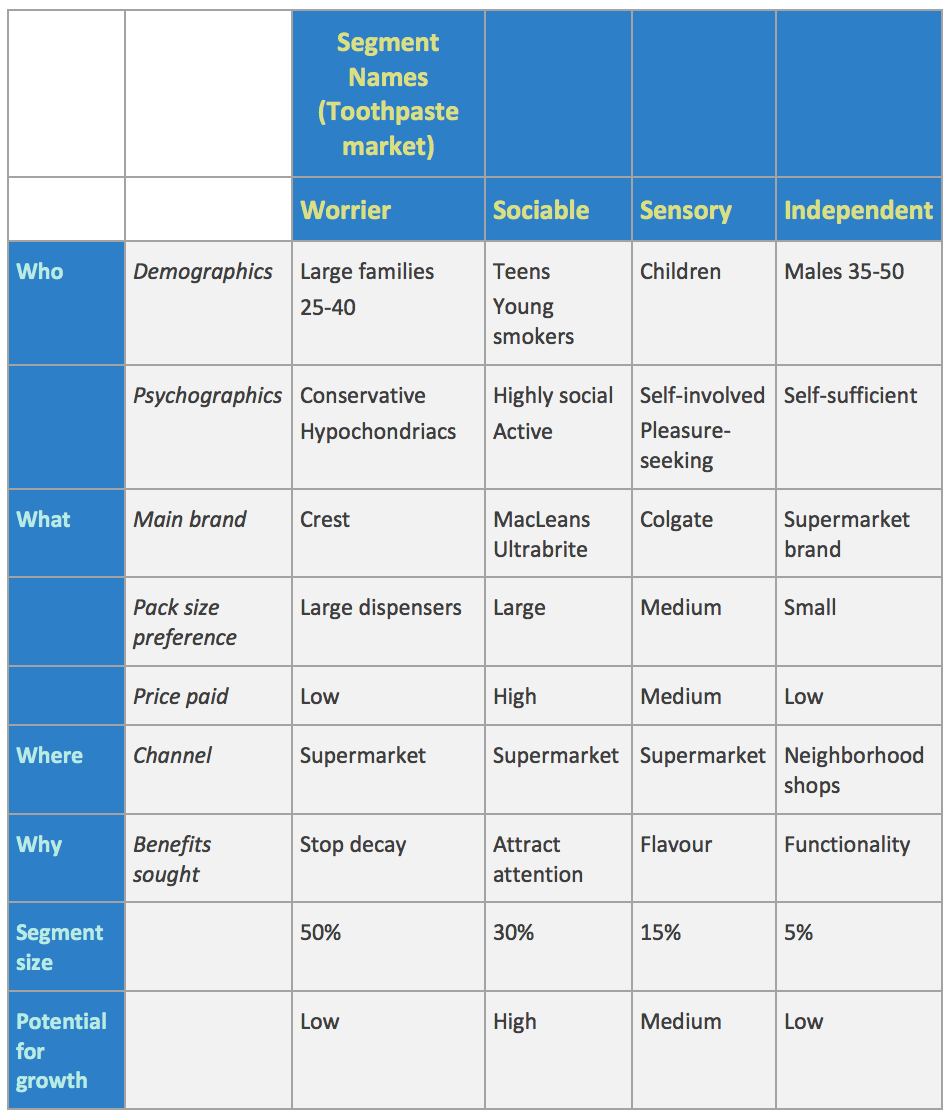Market segmentation research is research that is used to help a firm identify segments in a market, with the end goal of developing different strategies and tactics for the different segments (i.e., market segmentation). Market segmentation research is often referred to as segmentation research.
Download your free DIY Market Segmentation ebook
The output of segmentation research
The table below is an example of the end-point of a basic segmentation study. It describes four segments of toothpaste buyers. Typically, there will be a lot more information than shown here, both in terms of richer qualitative information and detailed tables of differences between segments.

Types of segmentation research
Broadly speaking, segmentation research can be classified into four broad types of methodology:
- Quantitative survey-based research
- Research carried out on secondary data
- Research carried out based on company databases
- Qualitative research
Quantitative survey-based research
Survey-based research involves the collection of data from a survey of people in the market of interest, and then using a segmentation algorithm, such as k-means cluster analysis or latent class analysis, to form segments. This is the main way that companies form market segments, because/since this method is the most flexible and produces the most detailed outputs, in that:
- Any form of data can be collected, such as demographics, behavior, attitudes, price sensitivity, preferences, etc.
- As a byproduct, it can produce all the key bits of information that are required for the implementation of the market segmentation (e.g., the size of the segments, the differences between segments in their attitudes, media viewing, etc.)
Research carried out on secondary data
Secondary data is data that has already been collected and is usually in the public domain. Most commonly this is data collected by government statistical agencies, such as census data. Segmentations based on secondary data tend to focus on demographics.
Research carried out based on company databases
Segmentation research studies based on company databases tend to focus on behavioral data, such as frequency and types of products purchased, customer value, and loyalty.
Qualitative research
The three most common qualitative research methods are focus groups, in-depth interviews, and ethnography. The strength of qualitative research is its ability to provide complex textual descriptions of how
people experience a given research issue. One advantage of qualitative methods in exploratory research is that the use of open-ended questions and probing gives participants the opportunity to respond in their own words. Researchers often use qualitative and quantitative material to complement each other. The final qualitative report containing descriptions and estimates of the sizes of the segments.
The term rich data describes the notion that qualitative data and their subsequent representation should reveal the complexities and the richness of what is being studied and the type of data that can be used for forming segments. However, they present the most challenges in terms of implementation, since/because the nature of the research means that much of the information required for effective implementation is missing (e.g., media usage, the size of the segments).
Download your free DIY Market Segmentation ebook
Acknowledgments
The table of outputs is adapted from Haley, R. I. (1968). "Benefit Segmentation: A Decision Oriented Research Tool." Journal of Marketing 30(July): 30-35.
Learn more about Market Segmentation
To learn more, download our free guide to Market Segmentation!

